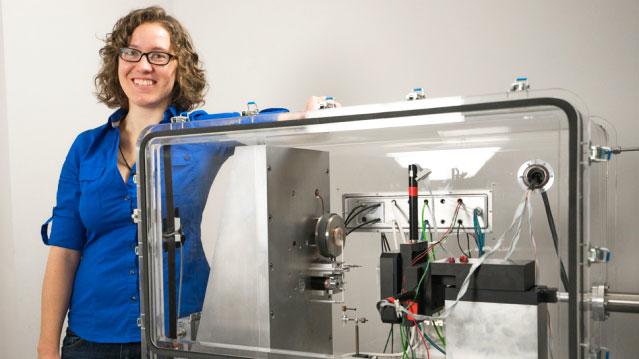actuator
Latest

This hip-hugging exosuit uses AI to make walking and running easier
Robotic devices have been used to help people walk or run in rehabilitation settings, but until now, they've been tethered and limited to a single action, like walking or running. In a paper published in Science today, a team of researchers explain how they're going to change that. The researchers -- from Harvard University and the University of Nebraska Omaha -- have developed a portable exosuit that uses AI to assist users with both walking and running.

MIT's mechanical actuators bend and 'breathe' as they heat up
Researchers from MIT and other institutions have developed a new type of actuator -- a mechanical component relying on movement -- that works in extremely hot environments. Their newly developed material could be used in, say, maintenance robots working in nuclear reactors. To achieve this temperature pliability, the scientists' new system uses oxide systems like those used in rechargeable batteries: As ions move in and out, they expand and contract. Similarly, the researchers' material bends with the flow of oxygen in and out.

Tiny pneumatic actuator makes soft robots practical
Soft robots that bend and stretch are cool concepts, but there's usually a lot of clunky hardware involved to make them work, like air compressors and gas generators. They're seldom practical in real life. However, Okayama University researchers have developed a tiny pneumatic actuator that should make those squishy automatons viable. The machinery changes pressure by turning water into hydrogen and oxygen (through a catalyst) in a matter of seconds, and reversing that process about as quickly. All it needs to get going is some electricity -- it doesn't require moving parts or vents, and it's effectively silent.

Caltech self-healing chips can recover from laser blasts, save power while healthy
While many scientists have heard the call for self-healing electronics, their previous projects have usually had just a limited capacity to come back from the brink. Caltech has developed an integrated circuit that could take much more of a bruising. Its prototype power amplifier chip has a dedicated circuit and sensors that can change actuators in microseconds if there's damage, re-optimizing the connections on the spot. And the chip can take a lot of that damage -- 76 examples in a penny-sized cluster endured multiple laser strikes in tests (like the one above) while still ticking. The self-healing even helps while everything is in tip-top shape, as it can cut power use by watching for the usual hiccups in load and voltage. So long as Caltech can develop the technology beyond its currently expected niches of communication and imaging, many of our computing devices could eventually take a few bumps and scrapes on the inside, not just their rugged exteriors.

DigitalOptics' fast MEMS camera enables Lytro-like post-capture refocus (video)
Tech shows like CES and MWC are great for taking a peek at what's coming up in the world of consumer electronics, even down to the component level. At the latter show this year, we came across DigitalOptics whose name may not sound familiar, but you may already be using its HDR, red eye removal, face tracking, face beautification and other related technologies on many phones (like Oppo's) and cameras (sorry, not allowed to name them here). Now, this year the company will also be offering its MEMS (microelectromechanical system) lens actuator which, compared to its traditional voice coil counterpart, is apparently more reliable, longer lasting, more efficient and faster with a 10ms settling time instead of the usual 20 to 25ms.

AMP-Foot 2.0 prosthesis gives the power of real feet, keeps a light step (video)
It was five years ago that prosthetics took a very literal step forward when Arizona State University's SPARKy foot offered a more natural walk, capturing the inherent kinetic energy that previously needed a big motor to replicate. Belgium's Vrije Universiteit Brussel may well carry the torch for the next wave of artificial limbs. Its second-generation Ankle Mimicking Prosthetic Foot (AMP-Foot 2.0) uses a pair of force sensors to determine the leg's relative position and let an actuator build energy when the foot bends, locking the power away to use only when the owner pushes off. The efficiency produces all the torque needed to let a 165-pound person walk, but with just a 30W to 60W motor versus SPARKy's 150W -- a big help to battery life that also reduces the AMP-Foot 2.0's weight to that of the fleshy kind. We don't know how likely it is the Belgian prosthesis goes beyond the prototype phase; if we had our way, it would move just as quickly as future wearers undoubtedly will.

Rethink delivers Baxter the friendly worker robot, prepares us for our future metal overlords (video)
No one would characterize existing factory robots as especially warm and fuzzy: they're usually disembodied limbs that are more likely to cut you than hug you. Rethink Robotics wants to put a friendly face on those machines, both figuratively and literally. Its about-to-ship Baxter worker robot carries a touchscreen face that's as much about communicating its intent as giving humans something more relatable. Likewise, it's designed to be easily programmed by its organic coworkers and react appropriately -- you guide Baxter by one of its two arms to tell it what to do, and its combination of cameras and a quad-core processor let it adapt to real-world imperfections. Even the series elastic actuators in its arms give it a softer, subtler movement that's less likely to damage products or people. While Baxter isn't as ruthlessly quick as most of its peers, the relatively low $22,000 price and promise of an SDK for its Linux brain in 2013 should make it easier to accept than the six-digit costs and closed platforms of alternatives. We just hope we're not being lulled into a false sense of security as lovable robots invade our manufacturing base ahead of the inevitable Robopocalypse. [Thanks to everyone who sent this in]

NASA, GM working on a 'Robo-Glove' to assist astronauts and autoworkers alike
We've seen power assist technology designed to help people walk, bike or just tote luggage around, and now we've for the Human Grasp Assist aka Robo-Glove. Under development from GM and NASA, the project takes inspiration from technology designed to give Robonaut 2 a hand capable of using tools designed for humans to embed actuators in the top of the glove that provide additional grip for the hands of meatbags. Once its pressure sensors detect the wearer is picking up a tool the synthetic tendons retract, holding them there until the sensor gives the signal to release. Current prototypes still weigh about two pounds and run off of a belt-mounted lithium-ion battery, although we still find the idea preferable to humanoid replacement like the impervious-to-baseball-bats DLR Hand System. By reducing the amount of force factory workers need to hold a tool from 15 to 20 pounds to just 5 to 10 pounds its expected to cut down the risk of repetitive motion injuries -- we'll wait for the fourth generation model to see what they can do for bloggers or Lee Evans. Until then, check after the break for a press release and quick demonstration video.

Kinect-driven tactile bodysuit makes you tingle in eight different places
We know the US Army has already experimented with vibrating clothing, and soon it could be our turn. The trendy figure-hugger above is rigged with haptic actuators across the arms and torso, which respond when the wearer's body 'touches' virtual objects created via Microsoft's Kinect platform. The outfit's designers at the University of Aachen spent just a few hundred dollars on components, aside from the cost of the Kinect, so this might well have commercial potential. Click the source link if you're really keen to see a concept video -- although it doesn't consist of much beyond a German dude doing the Hey Macarena in his socks. [Thanks, Jarod]

Sony prototypes pressure-sensitive tactile touchscreen, hopes to use it ASAP
Sony may come up with some far-out ideas, but the company insists this one's a bit closer to home: it's a LCD touchscreen with force sensing resistors and piezoelectric actuators that can detect how much pressure is applied and vibrate the panel respectively. Tech-On was rocking the scene at Open House 2010, and reports that the Cover Flow-like interface shuffled icons faster the harder a demonstrator pressed down, an interesting UI quirk in and of itself. Though the publication sadly didn't get to test out the tactile feedback for themselves, Sony said commercialization might not be too far off -- when asked about that telling Sony Ericsson logo, the company asserted that it'd like to see the tech in mobile phones "as soon as possible." We'd love to hold them to that, but unfortunately the applied pressure mechanic is just a prototype at this point.

Artificial Muscle ramps up production -- expect touchscreens that push back in 2011
Last we heard from Artificial Muscle, the company was trying to convince hospitals, cell phone manufacturers and more that its technology -- a silicon film that expands and contracts with an applied voltage -- would provide a real sense of touch to their cold, hard touchscreens. On at least three counts, it has succeeded. The San Jose Mercury News reports that two cell phone manufacturers are planning Artificial Muscle-based products in 2011, and that an "electronics entertainment product" will be released this Christmas. The company also plans to produce 1 million of the electronic actuators per month to anticipate further demand. While the Mercury News notes that Artificial Muscle's product isn't the holy grail of haptic feedback -- the entire screen stiffens when pressed, not just the spot you touch -- its adoption means the company may have set events in motion to ultimately reach that goal.

Crowson's Shadow Actuator rumbles your rump, won't damage your ears
Certainly you've heard of the bass shaker concept by now, right? If not, here's an alternative from Crowson that should make things crystal clear. The firm's new Shadow, which is obviously targeting the custom install market, gets bolted beneath any theater seat in which more bass is desired. When hooked up, the "Tactile Motion" feedback provides the wondrous feeling of bass without the hearing loss associated with cranking things to 11. Additionally, each chair can be controlled independently, meaning that some viewers could experience more rumble than others. Sadly, there's no mention of a price, but we're sure you can find an inflated one by phoning up your nearest HT dealer.






